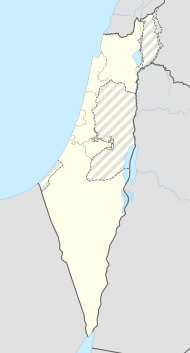Spray
| Spray | ||
|---|---|---|
| Basic data | ||
| hebrew : | ג'ש | |
| arabic : | الجش | |
| State : |
|
|
| District : | North | |
| Coordinates : | 33 ° 1 ' N , 35 ° 27' E | |
| Height : | 745 m | |
| Area : | 6.916 km² | |
| Residents : | 3090 (as of: 2018) | |
| Population density : | 447 inhabitants per km² | |
| Community code : | 0487 | |
| Time zone : | UTC + 2 | |
| Website : | ||
|
|
||
Gisch ( Arabic الجش al-Jish , DMG al-Ǧiš ; Hebrew ג'ש) is a Christian-Aramaic place in the Israeli northern district at the foot of the Meron , between Safed and the Lebanese border. The place has the status of a municipal administration .
General
The place has 3090 inhabitants (2018) and covers an area of 6.9 km². Almost two thirds of the residents of Gisch are Christians ; they belong to the greater part of the Maronite Church and to the smaller part of the Greek Catholic Church . About 35% of the residents are Muslim .
history
Antiquity
Gisch has been documented as a continuously inhabited and fortified village since the land conquest under Joshua , the oldest finds are up to 4,500 years old. The ancient name is in Flavius Josephus Gischala Γισχάλα and in the Talmud Gush Chalav (גוש חלב), which means "block of milk" . Under the Arab-Islamic rule the name changed to today's Gisch or Jisch.
During the Jewish War , Gush Chalav with its closed city wall and underground escape tunnel was the last center of resistance against the Roman army. The leader of Gush Chalav, Yohanan ben Levi , found himself inferior to the invading army under the leadership of Titus with his retinue of around 400 fighters . He negotiated the surrender of Gush Halav for the day after Shabbat with Titus, but the night before ben Levi fled with his fighters and a majority of the residents.
Middle Ages and Modern Times
Gisch was of great importance for the Jewish community until the high Middle Ages due to its synagogue and rabbi graves. In the 17th century the place was inhabited by Druze, but the Gisch left at the end of the century. From the 18th century on, Gisch was settled mainly by Muslims, but also by Christian Arabs. The entire place was destroyed in the earthquake on January 1, 1837, the number of victims fluctuates between 135 and over 200 lives, depending on the source.
20th century
In Israel's War of Independence , many of the Arab inhabitants fled. When the Israeli army captured the site on October 29, 1948 during Operation Hiram , heavy fighting broke out in which numerous buildings were damaged or destroyed. In 1949 residents from the destroyed Christian-Arab towns of Ikrit and Bar'am were settled here, making the Christian Arabs the majority in Gisch. The majority of Christians are Maronite , the other part Greek Catholic .
21st century
Since 2014, Arameans have been recognized in Israel as an independent national population group. Maronite-Christian residents of Gisch take part in the revival of the Syrian-Aramaic identity, language and culture.
Famous residents
- Elias Chacour (* 1939), retired Archbishop of the Melkite Greek Catholic Church , grew up in Gisch from the age of 10.
- Johann von Gischala (unknown – after 70), leader during the Jewish uprising
literature
- Immanuel Benzinger : Gischala . In: Paulys Realencyclopadie der classischen Antiquity Science (RE). Volume VII, 1, Stuttgart 1910, column 1370.
Individual evidence
- ↑ אוכלוסייה ביישובים 2018 (population of the settlements 2018). (XLSX; 0.13 MB) Israel Central Bureau of Statistics , August 25, 2019, accessed May 11, 2020 .
- ↑ אוכלוסייה ביישובים 2018 (population of the settlements 2018). (XLSX; 0.13 MB) Israel Central Bureau of Statistics , August 25, 2019, accessed May 11, 2020 .
- ↑ The dream of your own village. In: Israelnetz .de. December 21, 2018, accessed January 13, 2019 .
